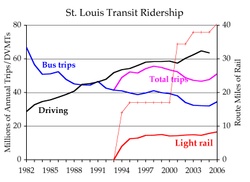Moral Hazard
The Anti-Planner has a series of posts of late on light rail that in total point to a perverse moral hazard in public transportation funding that helps to explain why states and cities are building so many rail projects, when the numbers almost never make any sense (as I blogged for LA, Phoenix, and Albuquerque). Though the Anti-Planner does not state these rules, from his recent posts I have inferred three rules:
- A city can get capital construction dollars from the feds, but you can almost never get maintenance or operations money (similar story in recreation)
- The feds will fund big, expensive, sexy rail projects. They will not fund purchases of buses and are unlikely to fund something so prosaic as a bus stop or terminal (general rule of thumb: federally funded projects must be large enough to justify being named at some future point after the local Congressman or Senator who earmarked the project.)
- It is very easy to de-fund bus systems -- you just don't replace aging buses and cut routes over time. It is hard to de-fund, or, god forbid, abandon a rail line, since the thing sits out there so visibly. Sunk costs can also be a political issue if rail lines were to be closed.
For most public transportation goals, particularly in spread out western and southern cities, buses are a cheaper and higher service solution than rail. They can carry the same passenger traffic for far less total dollars (capital plus operating costs) and they can cover far more routes. In fact, one can argue that rail lines are inherently regressive, as they tend to serve commuting corridors of the middle and upper classes rather than the typical routes of the poor, for whom the systems are nominally built.
So what can one expect by the application of these three rules? Well, we would expect local authorities to favor large, expensive capital rail projects rather than refurbishment or expansion of bus systems. As operating costs rise for the trains, we would expect bus service to be cut back to pay for the rail operating deficit.

Which is exactly what happens. In fact, rail tends not to increase total ridership at all, at best shifting ridership from inexpensive buses to expensive trains, and at worst decreasing total ridership as rail lines with just a few stations and routes replace more extensive webs of bus transport. And, in twenty years, when these rails systems need extensive capital overhauls, we find cities with huge albatrosses on their hands that they are unable to maintain or update.
Warren: I agree with most of your points, but you're committing the error of granting moral sanction:
"...rail lines are inherently regressive, as they tend to serve commuting corridors of the middle and upper classes rather than the typical routes of the poor, for whom the systems are nominally built."
Is your point that there is a better way to redistribute income from those who produce to those who don't? If not, then why say that rail is "regressive"?
But buses are oh so awful. If you have nothing else, they're something that will get you close to where you're going from close to where you are, but most of the people using them hate them.
The number one reason I've heard for why people buy cars after using bus transportation: "So I never have to ride the bus again."
I agree with your points about rail. They're big, sexy projects that politicians can stand around at a ribbon cutting on a sunny day, beaming for cameras. And when the people are standing on the platforms watching full trains come in and go through the station, because headways are too long because they can't afford to run more trains, those politicians are nowhere to be found.
I love rail. I hate the way it's done for commuters.
A couple of points:
Cities can get federal dollars for rail systems. There are no federal programs for operating subsidies, but most cities fund at least part of their operations with federal funds that are classified as 'urbanized area' funds and are allocated to cities on the basis of certain criteria (e.g. population, urbanized area density, etc.).
Politicians do favor expensive, capital-intensive projects because they are visible, but also because they are seen as catalysts for real estate development. These developments are also typically subsidized by local governments and take the form of the dense, compact neighborhoods that urban planners admire.
In fact, it is strikingly hard to de-fund bus systems. San Jose did so only because it bungled its finances so badly in its pursuit of a light rail system that it could not tease any more sales tax revenues out of the voters. It was a calculated risk that backfired on the VTA. In most cases, even minor proposals to reduce or eliminate underused bus services require public hearings at which many emotional pleas are registered by those who would be inconvenienced, many of whom are poor, have physical disabilities, or both. This usually results in some last minute wrangling to find funds to keep the service running. The other outcome is a new proposal for higher taxes to finance existing or even expanded service. This is why most larger-than-expected rail deficits lead to even high taxes.
Finally, most cities are not prepared to replace or rehabilitate their rail capital stock. However, you can expect that the federal government will come along just in time with a new gas tax to finance these costs. This will, of course, be the outcome of heavy lobbying by big city mayors, some environmentalists, and the American Public Transit Association.